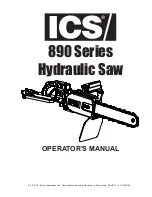
9. Replacing the power cable
If the power cable for this equipment is
damaged, it must be replaced by the
manufacturer or its after-sales service or
similarly trained personnel to avoid danger.
10. Cleaning, maintenance,
storage and ordering of
spare parts
Important.
Always pull out the power plug before starting
any cleaning work.
10.1 Cleaning
■
Keep all safety devices, air vents and the
motor housing free of dirt and dust as far as
possible.
■
We recommend that you clean the
equipment immediately after you use it.
■
Open the left cover (Fig. 1/Item 7) and
remove coarse contaminants (sawings,
dust) with a hand broom.
■
Wipe the equipment with a clean cloth or
blow it down with compressed air at low
pressure.
■
Clean the equipment regularly with a damp
cloth and some soft soap. Do not use
cleaning agents or solvents; these may be
aggressive to the plastic parts in the
equipment. Ensure that no water can get
into the interior of the equipment.
10.2 Servicing
There are no parts inside the equipment which
require additional maintenance.
10.2.1 Bearing(s) (Fig. 1/Item 8)
Periodically lubricate the bearings of the guide
rollers with high-grade machine grease, at the
latest however after 25 to 30 hours of operation.
10.2.2 Carbon brushes
In case of excessive sparking, have the carbon
brushes checked only by a qualified electrician.
Important: The carbon brushes should not be
replaced by anyone but a qualified electrician.
10.3 Storage
Store the equipment and accessories out of
children’s reach in a dark and dry place at
above freezing temperature. The ideal storage
temperature is between 5 and 30 °C. Store the
electric tool in its original packaging.
10.4 Ordering replacement parts
The following information must be provided on
all orders for spare parts:
■
Model/type of the equipment
■
Article number of the equipment
■
ID number of the equipment
For our latest prices and information please go
to www.isc-gmbh.info.
11. Disposal and recycling
The equipment is supplied in packaging to
prevent it from being damaged in transit. The
raw materials in this packaging can be reused
or recycled. The equipment and its accessories
are made of various types of material, such as
metal and plastic. Defective components must
be disposed of as special waste. Ask your
dealer or your local council.
For EU countries only
Never place any electric power
tools in your household refuse.
To comply with European Directive 2002/96/EC
concerning old electric and electronic
equipment and its implementation in national
laws, old electric power tools have to be
separated from other waste and disposed of in
an environment-friendly fashion, e.g. by taking
to a recycling depot.
16
GB/
IE
Anleitung_4309026:_ 19.07.2010 15:36 Uhr Seite 16







































